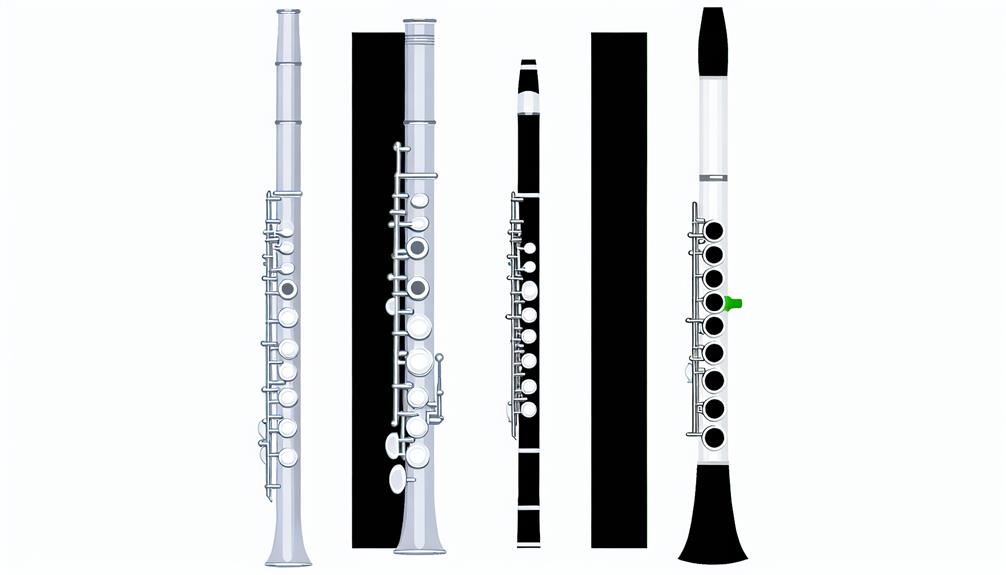Within the realm of woodwind instruments, the flute family holds a distinctive place. When considering the three main members of this family, the concert flute immediately comes to mind.
However, the concert flute is just the tip of the iceberg. Delving deeper into the nuances of the flute family reveals two more intriguing members that offer unique qualities and tonal characteristics.
These lesser-known siblings of the concert flute play vital roles in both orchestral settings and solo performances, each bringing its own charm and allure to the ensemble.
Key Takeaways
- Concert flute: Versatile and bright with a three-octave range, a soprano voice in ensembles.
- Piccolo: High-pitched, compact, cuts through orchestral sound, ideal for energetic performances.
- Alto flute: Rich, velvety timbre in G key, enriches ensembles with unique resonant voice.
- Flute family: Concert flute, piccolo, and alto flute offer diverse tones, sizes, and roles in music.
Concert Flute
The Concert Flute, a staple in orchestras and ensembles worldwide, is a versatile and expressive instrument known for its bright and clear sound. Belonging to the woodwind family, this elegant instrument is often considered the soprano voice in the flute family due to its pitch range. Typically made of silver, nickel, or gold, the Concert Flute features a range of approximately three octaves and is capable of producing a wide array of tones, from delicate and ethereal to powerful and commanding.
Players of the Concert Flute, often referred to as flutists or flautists, hold a vital role in many musical compositions, providing melodic lines, harmonies, and occasional solos. The instrument's agility allows for intricate and rapid passages, showcasing the performer's skill and dexterity. Whether performing in a classical symphony, a jazz ensemble, or a contemporary pop band, flutists find a sense of community and connection through their shared love for this enchanting instrument.
Piccolo
Known for its distinctive high-pitched sound and compact size, the Piccolo is a member of the flute family that holds a unique position in the realm of musical instrumentation. This small but powerful instrument is about half the size of a standard concert flute and is known for its ability to cut through the sound of a full orchestra with its bright and piercing tone.
The Piccolo is often utilized in marching bands, concert bands, and orchestras to add a sparkling brilliance to the overall sound. Its high register and ability to play rapid passages make it a valuable asset in creating dynamic and energetic musical performances.
Despite its small size, the Piccolo requires a skilled musician to play it effectively due to its challenging high notes and tight fingerings. Players must have a strong embouchure to produce clear and resonant sounds on this instrument.
Alto Flute
Revered for its rich and velvety timbre, the Alto Flute holds a distinct place within the flute family for its unique tonal qualities and versatility in ensemble settings. The Alto Flute is pitched in the key of G, a perfect fourth below the standard C flute. This difference in pitch results in a lower, warmer sound that adds depth and color to musical pieces. Its larger size and longer tube allow for a more resonant and full-bodied sound, making it a valuable addition to orchestras, chamber ensembles, and flute choirs.
To highlight the key differences between the Alto Flute and the more commonly known C Flute, let's compare them in a table:
| Feature | Alto Flute | C Flute |
|---|---|---|
| Key | G | C |
| Pitch | Lower | Higher |
| Sound Characteristics | Rich, velvety, warm | Bright, clear, crisp |
| Usage | Orchestras, ensembles, flute choirs | Wide range of musical genres |
The Alto Flute's distinct sound and versatility make it an essential member of the flute family, offering a unique voice that enriches musical performances.
Frequently Asked Questions
What Are the Key Differences in Sound Between the Concert Flute, Piccolo, and Alto Flute?
The concert flute, piccolo, and alto flute each offer distinct tonal qualities. The concert flute produces a bright, clear sound, the piccolo is high-pitched and piercing, while the alto flute delivers a mellower, deeper tone.
Are There Any Other Members of the Flute Family Besides the Concert Flute, Piccolo, and Alto Flute?
In addition to the concert flute, piccolo, and alto flute, the flute family also includes other members such as the bass flute, contrabass flute, and subcontrabass flute. These larger instruments produce lower tones, expanding the range and versatility of the flute family.
How Does the Size of the Flute Affect Its Pitch and Range?
The size of a flute directly influences its pitch and range. Generally, larger flutes produce lower pitches and have a wider range, while smaller flutes create higher pitches with a narrower range. Size impacts the instrument's tonal characteristics significantly.
Are There Any Special Techniques or Extended Techniques Commonly Used on the Concert Flute, Piccolo, or Alto Flute?
Exploring the concert flute, piccolo, and alto flute unveils a world of sonic possibilities. Musicians often employ techniques like flutter-tonguing, multiphonics, and harmonics to add depth and texture, pushing the boundaries of traditional flute performance.
Are There Any Historical or Cultural Significance Associated With the Flute Family Members?
The historical and cultural significance of the flute family members spans centuries and continents. From ancient civilizations to modern orchestras, these instruments have played pivotal roles in rituals, ceremonies, and artistic expressions, shaping diverse musical traditions worldwide.
Conclusion
In conclusion, the flute family consists of three main members: the Concert Flute, Piccolo, and Alto Flute.
Each member of this musical family brings its own unique characteristics and qualities, creating a harmonious blend of sounds that resonate like a colorful bouquet of flowers blooming in a symphony of music.
Exploring the diverse range of tones and textures offered by these instruments allows for a rich and dynamic musical experience that captivates the senses.

